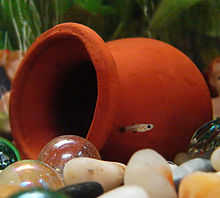This is an old revision of this page, as edited by 74.214.141.198 (talk) at 02:52, 18 September 2018 (→Common aquarium livebearers). The present address (URL) is a permanent link to this revision, which may differ significantly from the current revision.
Revision as of 02:52, 18 September 2018 by 74.214.141.198 (talk) (→Common aquarium livebearers)(diff) ← Previous revision | Latest revision (diff) | Newer revision → (diff)
Live-bearing aquarium fish, often simply called livebearers, are fish that retain the eggs inside the body and give birth to live, free-swimming young. Among aquarium fish, livebearers are nearly all members of the Poeciliidae family and include guppies, mollies, platies and swordtails.
The advantages of livebearing to the aquarist are that the newborn juvenile fish are larger than newly-hatched fry, have a lower chance of mortality and are easier to care for. Unusual livebearers include seahorses and pipefish, where the males care for the young, and certain cichlids that are mouthbrooders, with the parent incubating the eggs in the buccal cavity.